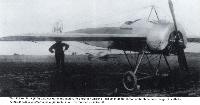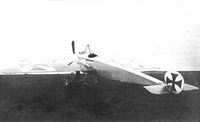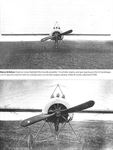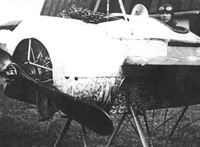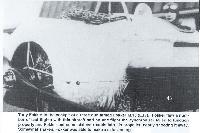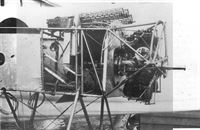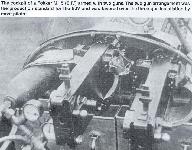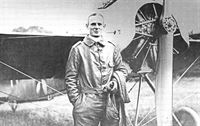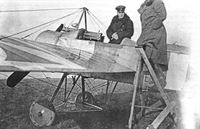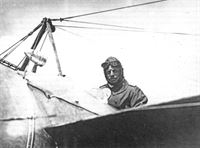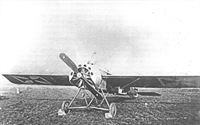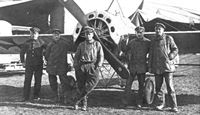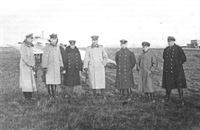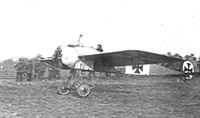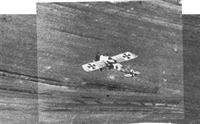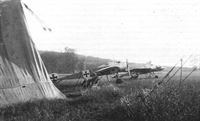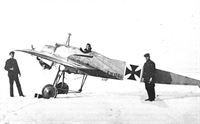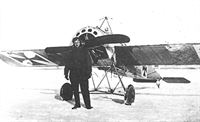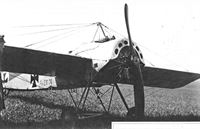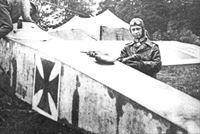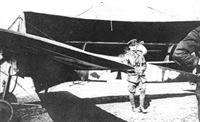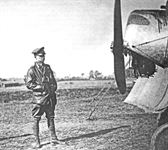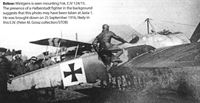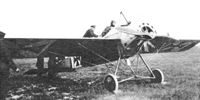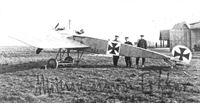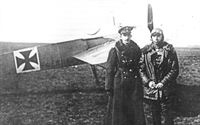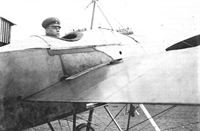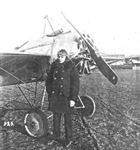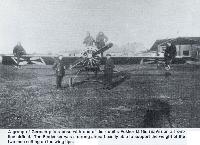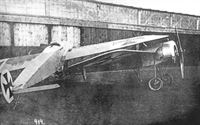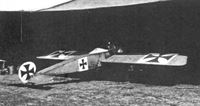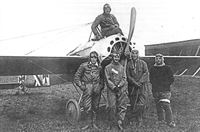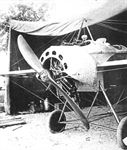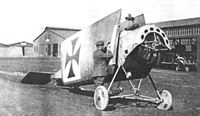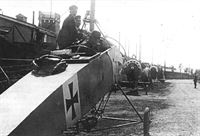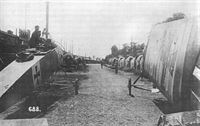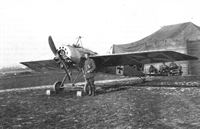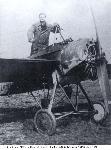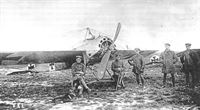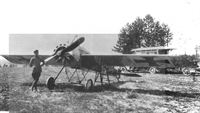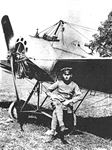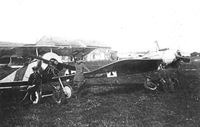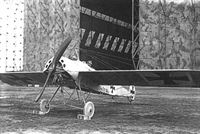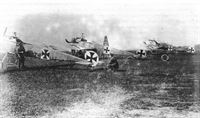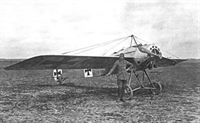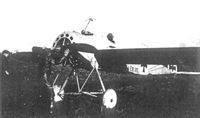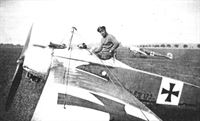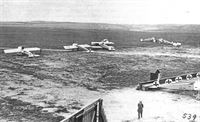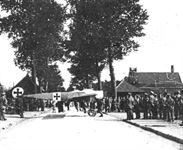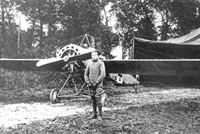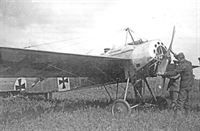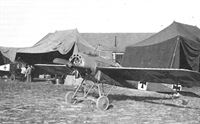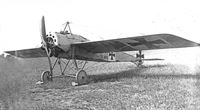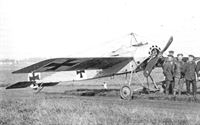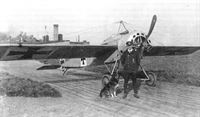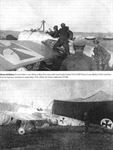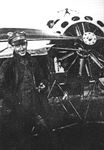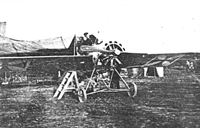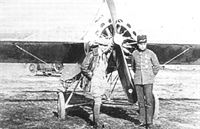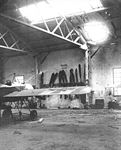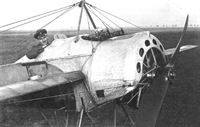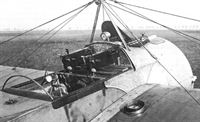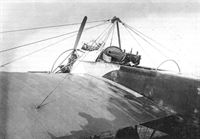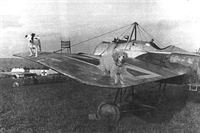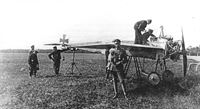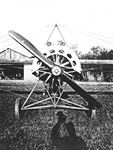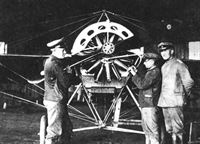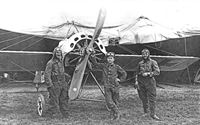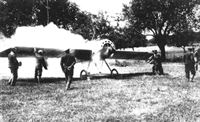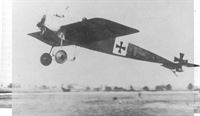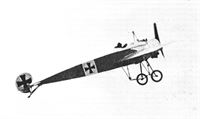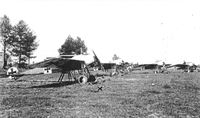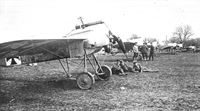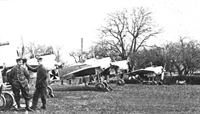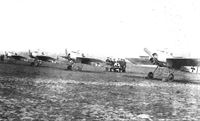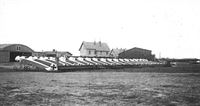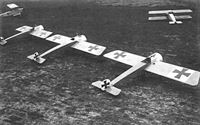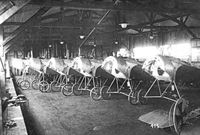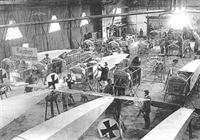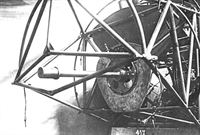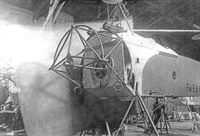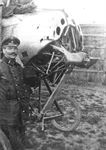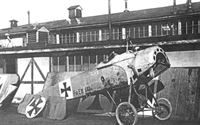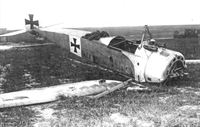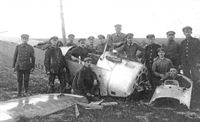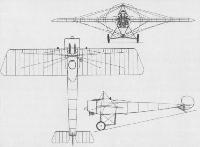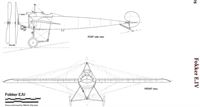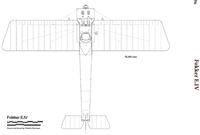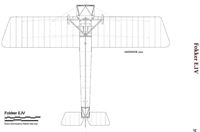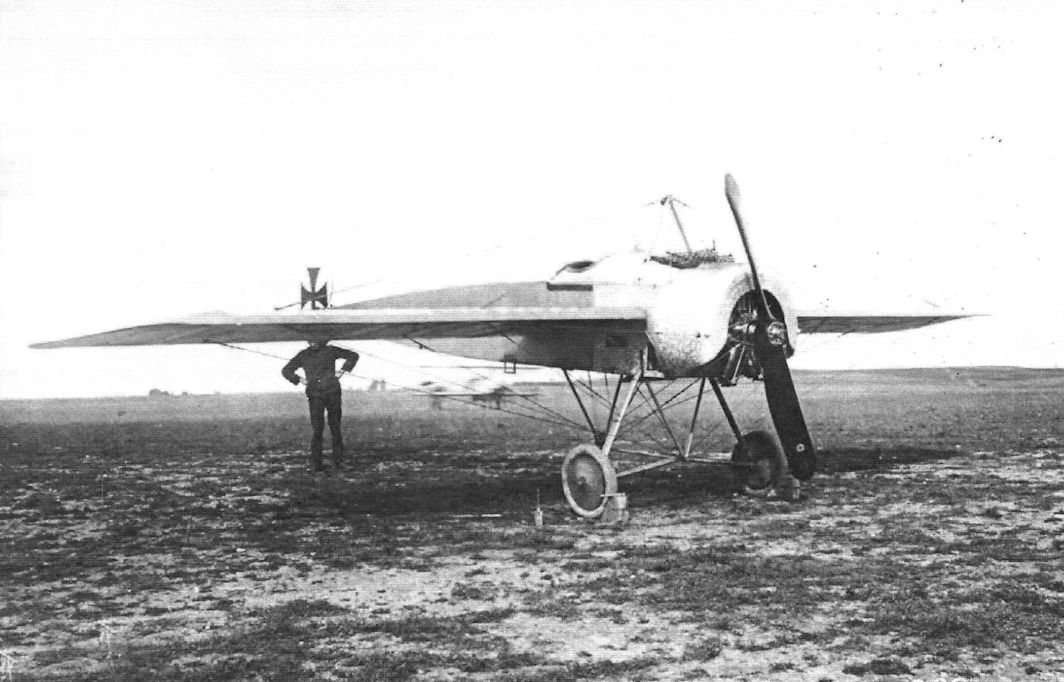
Описание
Страна: Германия
Год: 1915
Истребитель
Варианты
- Fokker - A.I / M.6 / M.8 - 1914 - Германия
- Fokker - A.II / A.III / M.5 - 1914 - Германия
- Fokker - E.I / E.II / E.III / M.14 - 1914 - Германия
- Fokker - E.IV / M.15 - 1915 - Германия
- В.Кондратьев Самолеты первой мировой войны
- A.Weyl Fokker: The Creative Years (Putnam)
- J.Herris, J.Scott Fokker Aircraft of WWI. Vol.2: Eindeckers (A Centennial Perspective on Great War Airplanes 52)
- O.Thetford, P.Gray German Aircraft of the First World War (Putnam)
- W.Green, G.Swanborough The Complete Book of Fighters
-
J.Herris, J.Scott - Fokker Aircraft of WWI. Vol.2: Eindeckers /Centennial Perspective/ (52)
Fokker E.IV 123/15 Oswald Boelcke KEK Sivry, spring 1916
-
J.Herris, J.Scott - Fokker Aircraft of WWI. Vol.2: Eindeckers /Centennial Perspective/ (52)
Fokker E.IV 126/15, Hartmuth Baldamus, FEA 20, Spring-summer 1916
-
Сайт - Pilots-and-planes /WWW/
The Fokker E.IV had a streamlined cockpit deck and twin Spandau machine guns.
-
J.Herris, J.Scott - Fokker Aircraft of WWI. Vol.2: Eindeckers /Centennial Perspective/ (52)
Fokker E.IV 437/15, Walter Hohndorff, FFA 12/KEK Falkenhausen, Spring-summer 1916
-
J.Herris, J.Scott - Fokker Aircraft of WWI. Vol.2: Eindeckers /Centennial Perspective/ (52)
Fokker E.IV 638/15 Possibly KEK 3, Douai Summer 1916
-
J.Herris, J.Scott - Fokker Aircraft of WWI. Vol.2: Eindeckers /Centennial Perspective/ (52)
Fokker E.IV 183/16 Rest 4, Freiburg, 1917
-
J.Herris, J.Scott - Fokker Aircraft of WWI. Vol.2: Eindeckers /Centennial Perspective/ (52)
Fokker E.IV 183/16, "Hannah" Kampfeinsitzer Staffel 4 Freiburg, Germany early 1917.
-
J.Herris, J.Scott - Fokker Aircraft of WWI. Vol.2: Eindeckers /Centennial Perspective/ (52)
Fokker E.IV 186/16, Unit unknown
-
J.Herris, J.Scott - Fokker Aircraft of WWI. Vol.2: Eindeckers /Centennial Perspective/ (52)
Fokker E.IV E.186/16 in gray green finish. The castor oil spray and the exhaust fumes have removed the paint aft and below the wing, revealing the unbleached fabric underneath.
-
J.Herris - Development of German Warplanes in WWI /Centennial Perspective/ (1)
Fokker E.IV flown by ace Kurt Wintgens while he was assigned to Flieger-Abteilung 6. The larger cowling for the two-row rotary distinguishes the E.IV from earlier E-types. Wintgens scored 19 victories and was awarded the Pour le Merite. He was killed in action 25 September 1916.
-
В.Кондратьев - Самолеты первой мировой войны
"Фоккер" E.IV, пилот Освальд Бельке, март 1917г.
-
Сайт - Pilots-and-planes /WWW/
This Fokker E.IV was flown by the famous German ace Oswald Boelcke during 1916.
-
В.Кондратьев - Самолеты первой мировой войны
"Фоккер" E.IV, K.E.K. (Кампфэйнситцкомандо) "Сиври", пилот - гауптман Освальд Бёльке, 1916 год.
-
J.Herris, J.Scott - Fokker Aircraft of WWI. Vol.2: Eindeckers /Centennial Perspective/ (52)
Fokker's M.15 design was a continuation of the M.14, modified to mount the more powerful 160 hp Oberursel U.III and carry a battery of three machine guns. This is the prototype, werknummer 298. (Peter M. Grosz collection/STDB)
-
Сайт - Pilots-and-planes /WWW/
This Fokker M.15 (E.IV) was set up at the factory to shoot a number of documentation photos of the three machine gun installation. Although Boelcke tested such a gun installation, he reportedly disliked it.
-
J.Herris, J.Scott - Fokker Aircraft of WWI. Vol.2: Eindeckers /Centennial Perspective/ (52)
Although it looks like there are only two LMG08s mounted in this photo of the M.15 prototype, the port gun is actually directly in line visually with the center MG. This airframe had the same "deflector plate" beneath the fuselage as seen on the previous E-types. (William Toohey)
-
J.Herris, J.Scott - Fokker Aircraft of WWI. Vol.2: Eindeckers /Centennial Perspective/ (52)
The fuselage of the E.IV was lengthened and the wings were moved closer to the nose in order to balance the heavier U.III engine, extra guns and ammunition.The tail unit, undercarriage and M.14 wings were retained from the previous Eindecker designs. The wings have a decidedly darker finish than the fuselage on M.15 w/n 298. (Peter M. Grosz collection/ STDB)
-
J.Herris, J.Scott - Fokker Aircraft of WWI. Vol.2: Eindeckers /Centennial Perspective/ (52)
Head-on views highlight the Garuda propeller, 14-cylinder engine, and gun spacing on the E.IV prototype. 122/15 was the only E.IV with no cooling holes cut into the engine cowling. (Peter M. Grosz collection/STDB)
-
Сайт - Pilots-and-planes /WWW/
This three-gun Fokker M.15 (E.IV) is unusual in that it does not have the cooling intakes around the front of the engine cowling.
-
J.Herris, J.Scott - Fokker Aircraft of WWI. Vol.2: Eindeckers /Centennial Perspective/ (52)
The prototype had wings with the werknummer 385. The darkness of the cockpit interior is evident here. (Peter M. Grosz collection/STDB)
-
H.Cowin - Aviation Pioneers /Osprey/
A factory documentation view near to pilot's-eye view of an experimental triple 7.92mm Spandau gun installation synchronized to fire through the propeller arc of this Fokker E IV. This fit was the culmination of Fokker's efforts to arm his early monoplanes, or eindeckers and although Max Immelmann tested this three-weapon fit, he preferred the Eindecker's standard single gun installation. The bar visible inside the cockpit was the firing control for the three guns.
-
J.Herris, J.Scott - Fokker Aircraft of WWI. Vol.2: Eindeckers /Centennial Perspective/ (52)
Anthony Fokker sits in the cockpit of M.15 w/n 298.The prototype was accepted as Fokker E.IV 122/15 on 19 September 1915 and left the factory on 27 September. (Peter M. Grosz collection/STDB)
-
Сайт - Pilots-and-planes /WWW/
Tony Fokker in the cockpit of a three gun armed Fokker M.15 (E.IV). Fokker flew a number of test flights with this aircraft and on one flight the synchronizer failed to function properly and Fokker put some sixteen rounds into his propeller, nearly shooting it away. Somewhat shaken, Fokker was able to make a safe landing.
-
J.Herris, J.Scott - Fokker Aircraft of WWI. Vol.2: Eindeckers /Centennial Perspective/ (52)
Раскапотированная носовая часть фюзеляжа "Фоккера" E.IV с двухрядным 14-цилиндровым ротативным двигателем "Оберурсель" U.III и максимальным набором вооружения - тремя синхронными пулеметами LMG 08.
That the Oberusel U.III engine was in fact two 7-cylinder U.0 engines bolted together is obvious here. With the first E.IVs, the LMG08 guns were mounted at a shallow angle, although not as extreme as the 15° often quoted. Each of the three guns had their own pushrod interrupter system. Unique to the first two E.IVs, the bottom longeron extended about a foot forward of the undercarriage legs. (Peter M. Grosz collection/STDB) -
M.Dusing - German Aviation Industry in WWI. Volume 1 /Centennial Perspective/ (84)
Three guns on Wintgens Fokker E.IV.
-
Сайт - Pilots-and-planes /WWW/
This is the gun installation on E.IV 122/15. Only the first three M.15 airframes had the structure to mount three LMG08s and only 122/15 had the fuel gauge set between the starboard and center guns. A compressed air tank replaced the port gun and may have been an experimental apparatus to pressurize the aft auxiliary fuel tank. With the exception of the previous photo, 122/15 was usually seen without the wind-driven generator seen on other E.IVs for this purpose. (Colin A Owers)
-
J.Herris, J.Scott - Fokker Aircraft of WWI. Vol.2: Eindeckers /Centennial Perspective/ (52)
After some modifications, E.IV 122/15 shipped again on 20 October and was evaluated at the front by Lt. Otto Parschau. The port MG was removed and a small spinner was added to the propeller boss. Also, an additional window was installed in the cockpit's fabric wall and the windscreen was replaced. (Peter M. Grosz collection/STDB)
-
J.Herris, J.Scott - Fokker Aircraft of WWI. Vol.2: Eindeckers /Centennial Perspective/ (52)
Otto Parschau stands in the cockpit of 122/15. Several additions had been made to the aircraft: the dataplates, a fuel gauge on the starboard side of the center gun, an anemometer on the port wing and the initials "AF" on the engine cowling. (Peter M. Grosz collection/STDB)
-
O.Thetford, P.Gray - German Aircraft of the First World War /Putnam/
Otto Parschau glares out from the confines of Fok. E.IV 122/15's enclosed cockpit. (Lance Bronnenkant)
-
J.Herris, J.Scott - Fokker Aircraft of WWI. Vol.2: Eindeckers /Centennial Perspective/ (52)
Parschau poses with Fok E.IV 122/15, which now carries a Rahtjen propeller and no spinner. (Peter M. Grosz collection/ STDB)
-
J.Herris, J.Scott - Fokker Aircraft of WWI. Vol.2: Eindeckers /Centennial Perspective/ (52)
Оберлейтенант Освальд Бельке готовится к взлету на своем "Фоккере" E.IV.
At Sivry, Fok. E.IV 123/15 had its wheel covers painted in thirds - red, white and black. (Peter M. Grosz collection/STDB) -
J.Herris, J.Scott - Fokker Aircraft of WWI. Vol.2: Eindeckers /Centennial Perspective/ (52)
Ernst Freiherr von Althaus arrived at Sivry after Boelcke's wingman, Werner Notzke, was killed in April. Althaus is at Boelcke's left, in front of E.IV 123/15. (Lance Bronnenkant)
-
J.Herris, J.Scott - Fokker Aircraft of WWI. Vol.2: Eindeckers /Centennial Perspective/ (52)
The cause of the 'Fokker Scourge'. A Fokker Eindecker E.IV with the German 'Ace' Oswald Boelcke in the cockpit. The forward-firing machine gun which made it such a feared adversary is clearly visible.
Fokker E.IV 123/15 (w/n 337) was the second E.IV built and was shipped from the factory on 27 November 1915. It was flown extensively by Oswald Boelcke as his personal aircraft. Although intended to carry three guns, it was delivered without the port MG. (Peter M. Grosz collection/STDB) -
J.Herris, J.Scott - Fokker Aircraft of WWI. Vol.2: Eindeckers /Centennial Perspective/ (52)
Boelcke prepares to fire up his Eindecker's Oberursel. U.III engine. The"bulldog" nose of E.IV 123/15 is evident here, a trait unique to this aircraft and E.IV 122/15. The Garuda prop has gained a small spinner. (Peter M. Grosz collection/STDB)
-
J.Herris, J.Scott - Fokker Aircraft of WWI. Vol.2: Eindeckers /Centennial Perspective/ (52)
Boelcke poses for a portrait in the cockpit of E.IV 123/15. The streamlined fuel gauge housing was set to the port of the center gun. (Peter M. Grosz collection/STDB)
-
J.Herris, J.Scott - Fokker Aircraft of WWI. Vol.2: Eindeckers /Centennial Perspective/ (52)
A wind-driven generator was mounted on the front undercarriage pylon of E.IV 123/16. This was used to maintain the air pressure in the aft auxiliary fuel tank. (Peter M. Grosz collection/STDB)
-
J.Herris, J.Scott - Fokker Aircraft of WWI. Vol.2: Eindeckers /Centennial Perspective/ (52)
Oswald Boelcke and his ground crew pose in front of E.IV 123/15 at the Sivry airfield after he had been transferred to the Verdun front. The initials "OB" can be seen on the engine cowling. (Peter M. Grosz collection/STDB)
-
J.Herris, J.Scott - Fokker Aircraft of WWI. Vol.2: Eindeckers /Centennial Perspective/ (52)
Fok. E.IV 123/15 sits in the background as the Einsitzer pilots of FFA 62 meet with visitors. From left to right: Lt. von Seckendorf, Hptm. Hermann Kastner (c.o. of FFA 62), Oswald Boelcke, General Arnim von Holstein, Max Immelmann, Lt. Albert Osterreicher and Lt.d.R. Ernst Hess. (Terry Phillips)
-
J.Herris, J.Scott - Fokker Aircraft of WWI. Vol.2: Eindeckers /Centennial Perspective/ (52)
In order to be closer to the front, Boelcke received permission to set up a two-aircraft unit at Sivry on 11 March 1916. This is E.IV 123/15 and a Fokker E.III at the Sivry aerodrome. (Peter M. Grosz collection/STDB)
Другие самолёты на фотографии: Fokker E.I / E.II / E.III / M.14 - Германия - 1914
-
J.Herris, J.Scott - Fokker Aircraft of WWI. Vol.2: Eindeckers /Centennial Perspective/ (52)
Fokker E.IV 123/15 takes off in front of a crowd at Douai. (Peter M. Grosz collection/STDB)
-
J.Herris, J.Scott - Fokker Aircraft of WWI. Vol.2: Eindeckers /Centennial Perspective/ (52)
Boelcke lifts off in E.IV 123/15 from KG 2's aerodrome at Mont. (Peter M. Grosz collection/STDB)
-
J.Herris, J.Scott - Fokker Aircraft of WWI. Vol.2: Eindeckers /Centennial Perspective/ (52)
Fok. E.IV 123/16 is seen in flight over the Verdun front. (San Diego Aerospace Museum)
-
J.Herris, J.Scott - Fokker Aircraft of WWI. Vol.2: Eindeckers /Centennial Perspective/ (52)
At some point in the summer of 1916, E.IV 123/15 was given a makeover. Here is sits, still at Sivry, with completely new turtledeck, fabric, and markings (including a partially legible armeenummer). Behind it is a later-production E.IV, also flown by Boelcke, with 6-pointed stars on the wheel covers. (Lance Bronnenkant)
-
J.Herris, J.Scott - Fokker Aircraft of WWI. Vol.2: Eindeckers /Centennial Perspective/ (52)
The third E.IV in sequence was Fok. E.IV 124/15 (w/n 374). It was the first to have the lower longeron angle upwards forward of the landing gear legs. It was also the first to have the aluminum side panels made with a curved trailing edge, although 124/15 had a unique curve-back at the bottom. (Peter M. Grosz collection/STDB)
-
J.Herris, J.Scott - Fokker Aircraft of WWI. Vol.2: Eindeckers /Centennial Perspective/ (52)
Kurt Wintgens was the recipient of E.IV 124/15 in late January 1916, possibly while he was with FFA 12 in Burlingshofen, and he would use it extensively up to his death in September 1916. Like the first two E.IVs, this M.15 was intended to have three LMG08s, but arrived at the front with only two, the space for the port gun having been covered over. (Peter M. Grosz collection/STDB)
-
J.Herris, J.Scott - Fokker Aircraft of WWI. Vol.2: Eindeckers /Centennial Perspective/ (52)
Fok. E.IV 124/15 is seen later, in the spring/summer of 1916. On the E.IVs, the underside aluminum panel was shaped to contain the landing gear's suspension bungees. (Peter M. Grosz collection/ STDB)
-
J.Herris, J.Scott - Fokker Aircraft of WWI. Vol.2: Eindeckers /Centennial Perspective/ (52)
Kurt Wintgens prepares for a sortie in E.IV 124/15, which now has wings with 1916-style crosses. (Peter M. Grosz collection/STDB)
-
J.Herris, J.Scott - Fokker Aircraft of WWI. Vol.2: Eindeckers /Centennial Perspective/ (52)
Wintgens is again seen with E.IV 124/15. The progressive fabric soiling tells us that this photo was taken after the previous shot, but the wings again have 1915-style crosses (with the white cross-field reduced on the upper surfaces), while the fuselage has updated national insignia. (Peter M. Grosz collection/STDB)
-
J.Herris, J.Scott - Fokker Aircraft of WWI. Vol.2: Eindeckers /Centennial Perspective/ (52)
Wintgens is again seen with E.IV 124/15.
-
J.Herris, J.Scott - Fokker Aircraft of WWI. Vol.2: Eindeckers /Centennial Perspective/ (52)
Much has been made about whether a 3-gun E.IV ever arrived at the front. Fokker lore has it that Immelmann received one. However, the photo presented here shows that there was indeed such a specimen in France - only it was in the hands of Kurt Wintgens. Fokker E.IV 124/15 is seen here, clearly with three LMG08s mounted. Wintgens had added in the third gun on his E.IV and overcome the issues with the three interrupter systems. (Lance Bronnenkant)
-
J.Herris, J.Scott - Fokker Aircraft of WWI. Vol.2: Eindeckers /Centennial Perspective/ (52)
Wintgens is seen mounting Fok. E.IV 124/15. The presence of a Halberstadt fighter in the background suggests that this photo may have been taken at Jasta 1. He was brought down on 25 September 1916, likely in this E.IV. (Peter M. Grosz collection/STDB)
-
J.Herris, J.Scott - Fokker Aircraft of WWI. Vol.2: Eindeckers /Centennial Perspective/ (52)
Baldamus achieved his first victory in this aircraft on 15 March 1916. In a letter home, he stated that only four pilots had received their E.IVs before him. Presumably, he meant Otto Parschau (E.IV 122/15), Oswald Boelcke (E.IV 123/15), Kurt Wintgens (E.IV 124/15), and Max Immelmann (E.IV 127/15). As E.IV 125/15 was tested to destruction, that leaves the likely candidate for this aircraft as Fok. E.IV 126/15. Unusually, a Wolff propeller is seen mounted on the Oberursel U.III in this photo. (Hannes Tager)
-
J.Herris, J.Scott - Fokker Aircraft of WWI. Vol.2: Eindeckers /Centennial Perspective/ (52)
Max Immelmann received Fok. E.IV 127/16 (w/n 377) on 16 January 1916. It had two LMG08s mounted symmetrically, as did Baldamus's machine and all subsequent E.IV production. (Peter M. Grosz collection/STDB)
The E.IV had a two-row, 160 hp Oberursel U.III rotary engine, and its larger cowling with additional cooling holes is clearly seen here. The additional power made the E.IV noticeably faster than the earlier Fokker fighters and enabled it to carry two machine guns. This makes the E.IV easy to distinguish from the earlier types, all of which look much alike and are often difficult to distinguish in photos. Immelmann was a famous early ace, and the Immelmann maneuver is named after him. -
J.Herris, J.Scott - Fokker Aircraft of WWI. Vol.2: Eindeckers /Centennial Perspective/ (52)
E.IV 127/15, Immelmann, and crew pose in front of the main hangar at Douai. (Lance Bronnenkant & AHT)
-
J.Herris, J.Scott - Fokker Aircraft of WWI. Vol.2: Eindeckers /Centennial Perspective/ (52)
Max Immelmann and Crown Prince Boris of Bulgaria pose in front of Fok. E.IV 127/15. Immelmann has his coat opened strategically to show off his medals, including his recently awarded Blue Max. (Peter M. Grosz collection/STDB)
-
J.Herris, J.Scott - Fokker Aircraft of WWI. Vol.2: Eindeckers /Centennial Perspective/ (52)
The smooth decking in front of the cockpit indicates that this E.IV was likely from the first production batch, 122-127/15. The pilot is Lt. Hartmuth Baldamus of FFA 20. (Peter M. Grosz collection/STDB)
-
J.Herris, J.Scott - Fokker Aircraft of WWI. Vol.2: Eindeckers /Centennial Perspective/ (52)
Leutnant Renatus Theiller of FFA 25 claimed his first victory on 25 March 1916, possibly in this early E.IV. After the first four of these new Eindeckers went to Fokker's favorite pilots, the others were doled out to the different Army groups, assigned to senior pilots with strong flying skills rather than combat victories. As an experienced pre-war flyer, Theiller may have received the initial E.IV for II Armee. The small circular hole in the side aluminum panel is unusual. (Coll. Jorg Muckler)
-
J.Herris, J.Scott - Fokker Aircraft of WWI. Vol.2: Eindeckers /Centennial Perspective/ (52)
Leutnant Walter Hohndorf of Fokkerstaffel Falkenhausen reclines on the tail of Fokker E.IV 437/15. The box painted on the fuselage beneath him reads Le Ramont 6.III.16, the significance of which remains elusive. (Peter M. Grosz collection/STDB)
-
J.Herris, J.Scott - Fokker Aircraft of WWI. Vol.2: Eindeckers /Centennial Perspective/ (52)
The werknummer 422 can be read on lower right corner of the fuselage fabric, identifying this as Fok. E.IV 439/15. The location is Schwerin-Gorries. (Dave Watts)
-
J.Herris, J.Scott - Fokker Aircraft of WWI. Vol.2: Eindeckers /Centennial Perspective/ (52)
As the pilot sitting on the wing at right is the same seen in the previous photo and this is the Gorries airfield again, this may also be E.IV 439/15. (William Toohey)
-
Сайт - Pilots-and-planes /WWW/
A group of German pilots pose with one of their unit’s Fokker M.15s (E.IVs) on a frontline airfield. The Eindecker was a strong aircraft easily able to support the weight of the two men setting on the wing tips.
-
J.Herris, J.Scott - Fokker Aircraft of WWI. Vol.2: Eindeckers /Centennial Perspective/ (52)
Fok. E.IV 439/15 had a run-in with Fok. E.III 605/15. No fuselage cross had been applied yet. (Peter M. Grosz collection/ STDB)
Другие самолёты на фотографии: Fokker E.I / E.II / E.III / M.14 - Германия - 1914
-
J.Herris, J.Scott - Fokker Aircraft of WWI. Vol.2: Eindeckers /Centennial Perspective/ (52)
Fokker E.III 605/15 had a run-in with E.IV 439/15. This may have occurred at Schwerin, as it has not had the fuselage insignia applied yet and it appears to be carrying a wooden machine gun. (Peter M. Grosz collection/STDB)
Другие самолёты на фотографии: Fokker E.I / E.II / E.III / M.14 - Германия - 1914
-
J.Herris, J.Scott - Fokker Aircraft of WWI. Vol.2: Eindeckers /Centennial Perspective/ (52)
Fokker E.IV 440/15 (w/n 423) is partially hidden in the shadows of its hangar. It was flown by Lt.d.R. Franz Zeno Diemer of FFA 32/KEK Bertincourt. Like Baldamus,Theiller, and Hohndorf, Diemer was an accomplished pre-war pilot. (Greg VanWyngarden)
-
J.Herris, J.Scott - Fokker Aircraft of WWI. Vol.2: Eindeckers /Centennial Perspective/ (52)
Fokker E.IV 638/15 wore a crossed sash and quartered wheel covers.The werknummer 475 can be read on the elevator. (Peter M. Grosz collection/STDB)
This Fokker M.15 (E.IV) was painted with crossed chevrons (believed to be Black and White) on the fuselage and quadrant-painted wheel covers. It is believed that this aircraft was flown by Max Immelmann. -
J.Herris, J.Scott - Fokker Aircraft of WWI. Vol.2: Eindeckers /Centennial Perspective/ (52)
The vintage and markings of this E.IV are the same as 638/15, so it could be the same aircraft. The pilots here were all members of KEK 3 in Douai. Vfw Wilhelm Viereck sits on top and, from left to right, we have Lt.d.R. Fritz Gerstle, Lt. Rudolf Heinemann, Lt.d.R. Hugo Joens, and Lt. Albert Osterreicher. Viereck had a confirmed Eindecker victory on 16 September 1916, downing a 2 Sqn BE2c. (Peter M. Grosz collection/STDB)
-
J.Herris, J.Scott - Fokker Aircraft of WWI. Vol.2: Eindeckers /Centennial Perspective/ (52)
Another photo of E.IV 638/15, in its hangar. (Peter M. Grosz collection/STDB)
-
J.Herris, J.Scott - Fokker Aircraft of WWI. Vol.2: Eindeckers /Centennial Perspective/ (52)
The werknummer 477 on the engine cover identifies this as E.IV 640/15, newly arrived at Armee-Flugpark 5 after leaving the factory on March 9. (Peter M. Grosz collection/STDB)
-
J.Herris, J.Scott - Fokker Aircraft of WWI. Vol.2: Eindeckers /Centennial Perspective/ (52)
Fokker E.IV 641/15 (w/n 478) receives final adjustments before being sent on its way from Schwerin on 22 April 1916. Facing it are another E.IV, a Fokker D.I, and a Fokker E.III. (Peter M. Grosz collection/STDB)
Другие самолёты на фотографии: Fokker D.I / M.16 / M.18 - Германия - 1916Fokker E.I / E.II / E.III / M.14 - Германия - 1914
-
J.Herris, J.Leckscheid - Fokker Aircraft of WWI. Vol.3: Early Biplane Fighters /Centennial Perspective/ (53)
The same group of aircraft photographed from the other end of the road. Fokker E.IV 641/15, seen at left, was shipped from Schwerin to the front for a second time on 18 August 1916, after being refurbished at the Fokker factory. The battered, engineless E.III is seen at right, note the worn appearance of the upper wing cross. The E.IV and several of the D.Is in these two photos still await their wings to be stacked next to their fuselages for transport.
Другие самолёты на фотографии: Fokker D.I / M.16 / M.18 - Германия - 1916Fokker D.II / M.17 - Германия - 1916Fokker E.I / E.II / E.III / M.14 - Германия - 1914
-
J.Herris, J.Leckscheid - Fokker Aircraft of WWI. Vol.3: Early Biplane Fighters /Centennial Perspective/ (53)
A wild mix of Fokker single-seaters is ready to be shipped to the front in mid-August. Photographed behind the Fokker factory at Hintenhof 43 in Schwerin, seen at left in this view area Fokker E.II followed by one D.I and seven Fokker D.II fighters. An engineless E.III, returned to the factory from the front, completes the lineup at left. Note the bright appearance of the D.I and D.II fabric compared to the E.III wing fabric. Seen at right are two D.Is (the second one an LF- marked Naval aircraft), a D.II, another D.I and an E.IV. This is Fokker E.IV 641/15 minus wings. A better view of this plane is available in the next photo.
Другие самолёты на фотографии: Fokker D.I / M.16 / M.18 - Германия - 1916Fokker D.II / M.17 - Германия - 1916Fokker E.I / E.II / E.III / M.14 - Германия - 1914
-
J.Herris, J.Scott - Fokker Aircraft of WWI. Vol.2: Eindeckers /Centennial Perspective/ (52)
Lt. Wilhelm Frankl flew Fok. E.IV 642/15 (w/n 479) with KEK Vaux. He may have achieved as many as five victories in this aircraft between May and August of 1916. (Reinhard Kastner)
-
J.Herris, J.Scott - Fokker Aircraft of WWI. Vol.2: Eindeckers /Centennial Perspective/ (52)
The werknummer on this E.IV could be 479, which would complete the partially-visible armeenummer as 642/15. (Peter M. Grosz collection/STDB)
-
J.Herris, J.Scott - Fokker Aircraft of WWI. Vol.2: Eindeckers /Centennial Perspective/ (52)
Fok. E.IV 161/16 was flown by Hans Karl Muller of KEK Avillers. It appears to have received some application of camouflage. The propeller is a Garuda, unusually clear-finished. The large bulge in the upper decking was for allowing manipulation of the cocking lever on the starboard LMG08. (Peter M. Grosz collection/STDB)
-
Сайт - Pilots-and-planes /WWW/
Leutnant Hans Muller in the cockpit of his Fokker M.15 (E.IV).(serial 161/16) April 1916.
-
J.Herris, J.Scott - Fokker Aircraft of WWI. Vol.2: Eindeckers /Centennial Perspective/ (52)
Fokker E.IV 163/16 was also on-hand with AOK 3. It seems to have shared the same style of sight for the two LMG08s. Presumably it was in use by the unit's c.o., Oblt, von Ascheberg, seen sitting on the port wheel. The other pilots here are Oblt. Fischer at left and Oblt. Kapis, Vfw. Kohler, and Gfr. Jahnke at right. (Peter M. Grosz collection/STDB)
-
J.Herris, J.Scott - Fokker Aircraft of WWI. Vol.2: Eindeckers /Centennial Perspective/ (52)
Oblt. Kurt Student stands with his late production E.IV at AOK 3 during June of 1916. As both 162/16 and 163/16 were assigned to this unit and looked largely identical, Student's E.IV could have been either. (Peter M. Grosz collection/STDB)
-
J.Herris, J.Scott - Fokker Aircraft of WWI. Vol.2: Eindeckers /Centennial Perspective/ (52)
Seen sometime later, Student had a headrest installed on his E.IV. The tripod gun sight and rearview mirror on the rigging pylon are still present. (Peter M. Grosz collection/STDB)
-
J.Herris, J.Scott - Fokker Aircraft of WWI. Vol.2: Eindeckers /Centennial Perspective/ (52)
Possibly taken on the same occasion as the previous photo, Kurt Student sits on top of his E.IV's turtledeck. The wheel covers have been painted a solid dark color. (Peter M. Grosz collection/STDB)
-
J.Herris, J.Scott - Fokker Aircraft of WWI. Vol.2: Eindeckers /Centennial Perspective/ (52)
Student stated that he use this E.IV for his first 3 victories. Here he poses with his E.IV and his first conquest, a Nieuport 11, which he had brought down on 6 July 1916. Student had the latter armed with an LMG08 and marked with German crosses. (Peter M. Grosz collection/STDB)
Другие самолёты на фотографии: Nieuport Nieuport-11/16 Bebe - Франция - 1915
-
J.Herris, J.Scott - Fokker Aircraft of WWI. Vol.2: Eindeckers /Centennial Perspective/ (52)
Fokker E.IV 164/16 is seen in front of the Zeppelin shed at Metz. It was shipped from Schwerin on 13 April 1916. A Heine propeller was mounted to the Oberursel U.III engine. (Peter M. Grosz collection/STDB)
-
J.Herris, J.Scott - Fokker Aircraft of WWI. Vol.2: Eindeckers /Centennial Perspective/ (52)
Fok. E.IV 165/16 sits with its panels removed between two Fok. E.IIIs of FFA 3b at Marimbois. (Reinhard Zankl)
Другие самолёты на фотографии: Fokker E.I / E.II / E.III / M.14 - Германия - 1914
-
J.Herris, J.Scott - Fokker Aircraft of WWI. Vol.2: Eindeckers /Centennial Perspective/ (52)
Fokker E.IV 167/16 sits ready on an airfield with what appears to be Fok. E.I 46/15. (Peter M. Grosz collection/STDB)
Другие самолёты на фотографии: Fokker E.I / E.II / E.III / M.14 - Германия - 1914
-
J.Herris, J.Scott - Fokker Aircraft of WWI. Vol.2: Eindeckers /Centennial Perspective/ (52)
An unidentified Fokkerflieger poses with E.IV 170/16, which looks to be newly arrived. (Peter M. Grosz collection/STDB)
-
J.Herris, J.Scott - Fokker Aircraft of WWI. Vol.2: Eindeckers /Centennial Perspective/ (52)
Fokker E.IV 172/16 was on-strength with FFA 62/KEK 3. It was known to have been used by Uffz. Wolfgang Heinemann, so it could be him in the cockpit here. Heinemann scored his first victory over a 23 Sqn FE2b on 26 June 1916 but was killed in action on 21 July. (Rainer Absmeier)
-
J.Herris, J.Scott - Fokker Aircraft of WWI. Vol.2: Eindeckers /Centennial Perspective/ (52)
Fok. E.IV 173/16 was assigned to FFA 3b at Marimbois. (Coll. Jorg Muckler)
-
J.Herris, J.Scott - Fokker Aircraft of WWI. Vol.2: Eindeckers /Centennial Perspective/ (52)
Possibly E.IV 173/16, definitely the same pilot seen above. The variations in ad-hoc sights for the dual LMG08s were nearly as numerous as the number of E.IVs built. (Peter M. Grosz collection/STDB)
-
J.Herris, J.Scott - Fokker Aircraft of WWI. Vol.2: Eindeckers /Centennial Perspective/ (52)
Fok. E.IV 174/16 has its engine run up as the ground crew wait for the signal to let go. (Peter M. Grosz collection/STDB)
-
J.Herris, J.Scott - Fokker Aircraft of WWI. Vol.2: Eindeckers /Centennial Perspective/ (52)
The Fokker factory flightline with original annotations by Peter M. Grosz.
Другие самолёты на фотографии: Fokker D.II / M.17 - Германия - 1916Fokker E.I / E.II / E.III / M.14 - Германия - 1914
-
J.Herris, J.Scott - Fokker Aircraft of WWI. Vol.2: Eindeckers /Centennial Perspective/ (52)
Fokker E.IV 176/16 is seen on the field at Schwerin-Gorries, in between the cellon-covered Fok. E.III 369/16 and a Fok. D.II. This E.IV was delivered from the factory on 31 May 1916 and was on-strength with Abwehrkommando Nord. Max Mulzer was known to have used this aircraft on 2 July during his brief assignment to that unit. (Peter M. Grosz collection/STDB)
Другие самолёты на фотографии: Fokker D.II / M.17 - Германия - 1916Fokker E.I / E.II / E.III / M.14 - Германия - 1914
-
J.Herris, J.Scott - Fokker Aircraft of WWI. Vol.2: Eindeckers /Centennial Perspective/ (52)
This Fokker E.IV had an audience as it was rolled through the streets of an unidentified town. The armeenummer appears to be 178/16, or 176/16. (Peter M. Grosz collection/STDB)
-
J.Herris, J.Scott - Fokker Aircraft of WWI. Vol.2: Eindeckers /Centennial Perspective/ (52)
Fok. E.IV 179/16 (w/n 568) was in use with FFA 19. This airframe was eventually sent to the Navy as a replacement for LF210. (Coll. Jorg Muckler)
-
J.Herris, J.Scott - Fokker Aircraft of WWI. Vol.2: Eindeckers /Centennial Perspective/ (52)
While with FFA 19, Fokker E.IV 179/16 was flown by Ernst Baron de Payrebrune de Saint Seve. (Collection Jorg Muckler)
-
J.Herris, J.Scott - Fokker Aircraft of WWI. Vol.2: Eindeckers /Centennial Perspective/ (52)
After delivery, Fok. E.IV 182/16 was flown by Oblt .Karl Abert of KEK 3. He was killed in combat on 22 September 1916, possibly in this aircraft. Note the circular sight on the LMG08. (Peter M. Grosz collection/STDB)
-
J.Herris, J.Scott - Fokker Aircraft of WWI. Vol.2: Eindeckers /Centennial Perspective/ (52)
Fokker E.IV 183/16 was dispatched from the factory on 10 June 1916 and was used by Ernst Freiherr von Althaus, probably with KEK Vaux. It looks to have had an additional large door fashioned into the upper decking to allow easier access to the machine guns. (Peter M. Grosz collection/STDB)
-
J.Herris, J.Scott - Fokker Aircraft of WWI. Vol.2: Eindeckers /Centennial Perspective/ (52)
Another shot of Fok. E.IV 183/16, having its engine run up. (Peter M. Grosz collection/STDB)
-
J.Herris, J.Scott - Fokker Aircraft of WWI. Vol.2: Eindeckers /Centennial Perspective/ (52)
Fokker E.IV 183/16 eventually ended up at Kest 4 in Freiburg, possibly after it had been returned to Schwerin for repair on 20 December 1916. It had gained a full coat of camouflage, the nickname Hannah and a new D-type rudder. (Peter M. Grosz collection/STDB)
-
J.Herris, J.Scott - Fokker Aircraft of WWI. Vol.2: Eindeckers /Centennial Perspective/ (52)
Fokker E.IV 186/16 (w/n 575) appears to have been given a coat of a solid mid-tone color, notably covering the nose and tail of the aircraft. Like 183/16, it has an additional access panel in the decking above the guns. A Pfalz E.IV is undergoing maintenance in the background. (Reinhard Kastner)
Другие самолёты на фотографии: Pfalz E.I/E.II/E.IV/E.VI - Германия - 1915
-
J.Herris, J.Scott - Fokker Aircraft of WWI. Vol.2: Eindeckers /Centennial Perspective/ (52)
Fok. E.IV 187/16 (w/n 576) looks much as it did when it left the factory. This aircraft does not appear to have the additional access panel in front of the pilot, as seen on the previous two examples. (Peter M. Grosz collection/STDB)
-
J.Herris, J.Scott - Fokker Aircraft of WWI. Vol.2: Eindeckers /Centennial Perspective/ (52)
The end of the line. Nominally, Fokker E.IV 189/16 (w/n 578) was the final E.IV of the last production batch of M.15 airframes. Having been accepted on 26 July 1916 and delivered on 3 August, it was not actually the last E.IV completed. E.IV 188/16 was shipped on 7 August 1916 and E.IV w/n 679 left Schwerin on 10 August. 189/16 had no wooden fairings on the landing gear legs or national insignia on the fuselage at this time. (Peter M. Grosz collection/STDB)
-
J.Herris, J.Scott - Fokker Aircraft of WWI. Vol.2: Eindeckers /Centennial Perspective/ (52)
The order for LF210 was completed using an aircraft that had previously been delivered to the Army, Fok. E.IV 179/16 (w/n 568). This E.IV was taken on-strength as (LF) 210/16 by the Navy in July 1916. (Oliver Wulff)
-
J.Herris, J.Scott - Fokker Aircraft of WWI. Vol.2: Eindeckers /Centennial Perspective/ (52)
Fok. E.IV LF210/16 was flown by Oberleutnant d.R.d.M.A. Kurt Mettlich of II MFFA. (Oliver Wulff)
-
J.Herris, J.Scott - Fokker Aircraft of WWI. Vol.2: Eindeckers /Centennial Perspective/ (52)
The early-production E.IVs in these two photos share numerous similarities which suggest that either or both may have been Baldamus's machine. Only 18 E.IVs were built that would have worn the 1915-style crosses, narrowing the possibilities. The fuselage stripe is green and white, Saxon colors for Baldamus. (Greg VanWyngarden & Rainer Absmeier)
-
J.Herris, J.Scott - Fokker Aircraft of WWI. Vol.2: Eindeckers /Centennial Perspective/ (52)
Ernst Freiherr von Althaus flew this very well-used early Fokker E.IV at KEK Sivry. It was likely in this machine that he had two victories in early May 1916. (Peter M. Grosz collection/STDB)
-
J.Herris, J.Scott - Fokker Aircraft of WWI. Vol.2: Eindeckers /Centennial Perspective/ (52)
Althaus takes a cigarette in front of a Fokker E.IV of indeterminate vintage. (Peter M. Grosz collection/STDB)
-
J.Herris, J.Scott - Fokker Aircraft of WWI. Vol.2: Eindeckers /Centennial Perspective/ (52)
An E.IV with 1915-style national insignia is prepared for use. (Peter M. Grosz collection/STDB)
-
J.Herris, J.Scott - Fokker Aircraft of WWI. Vol.2: Eindeckers /Centennial Perspective/ (52)
Anthony Fokker and Hans-Joachim Buddecke (on leave from his duties in the Dardanelles) stand with an early Fok. E.IV on the Schwerin-Gorries airfield. Buddecke would have been a prime candidate to receive an E.IV, had he been flying in France. (William Toohey)
-
J.Herris, J.Scott - Fokker Aircraft of WWI. Vol.2: Eindeckers /Centennial Perspective/ (52)
"Фоккер" Е.IV из "полевого авиаотряда" FeldFliegerAbteilung 19, 1916 год.
A largely unblemished late-production E.IV of FFA 19 is seen from an unusual angle. The pilot is Vfw. Gustav Diekmannshemke. (Peter M. Grosz collection/STDB) -
J.Herris, J.Scott - Fokker Aircraft of WWI. Vol.2: Eindeckers /Centennial Perspective/ (52)
This late E.IV has been raised while at rest in the hangar in order to relieve the tires from the weight of the aircraft. (Peter M. Grosz collection/STDB)
-
J.Herris, J.Scott - Fokker Aircraft of WWI. Vol.2: Eindeckers /Centennial Perspective/ (52)
A late-production E.IV is captured in a photo documenting the damage incurred to the roof of the hangar. (Peter M. Grosz collection/STDB)
-
J.Herris, J.Scott - Fokker Aircraft of WWI. Vol.2: Eindeckers /Centennial Perspective/ (52)
A fine close view of the nose of the same late E.IV seen above. The pronounced bulge in the upper aluminum decking allowed the pilot to manipulate the cocking lever of the LMG08. The drift wires for the wings attached to the front corners of the engine cage on the E.IV. The small tab on the leading edge of the wing is a stacking pad. (Lance Bronnenkant)
-
J.Herris, J.Scott - Fokker Aircraft of WWI. Vol.2: Eindeckers /Centennial Perspective/ (52)
A view inside the cockpit of a late-production Fokker E.IV. The aft crossbar supporting the LMG08s on these machines was level with the upper longeron. The brackets for holding the butt-end of the guns appear to be adjustable, perhaps allowing the pilot to change the angle of the guns. An altimeter is attached to the port side of the cockpit.
-
J.Herris, J.Scott - Fokker Aircraft of WWI. Vol.2: Eindeckers /Centennial Perspective/ (52)
This early E.IV had its aluminum decking removed for servicing. The aft fuel filler is visible, usually covered by the large turtledeck. The horizontal steel tube that supported the rear MG mounts was set lower on the "/15" E.IVs than on those from the 160-189/16 production batch. (Coll. Jorg Muckler)
-
J.Herris, J.Scott - Fokker Aircraft of WWI. Vol.2: Eindeckers /Centennial Perspective/ (52)
A very heavily soiled early E.IV of KEK Sivry plays host to a pair of canine wing-walkers. An additional port has been put into the upper decking, presumably to access the ammunition belts. (Peter M. Grosz collection/STDB)
-
J.Herris, J.Scott - Fokker Aircraft of WWI. Vol.2: Eindeckers /Centennial Perspective/ (52)
This is the same Sivry E.IV seen in the previous photo. Carl Holler cavorts with the unit pets in the first while a staffel-mate brings the proceedings to order in the second. The extent of the fabric staining suggests it had been with the unit for some time, probably coming over from KEK Jametz. (Peter M. Grosz collection/STDB)
-
J.Herris, J.Scott - Fokker Aircraft of WWI. Vol.2: Eindeckers /Centennial Perspective/ (52)
Vfw. Willy Glinkermann of KEK Habsheim was photographed with a late Fokker E.IV as it was being readied for service. Unfortunately, only the "/16" behind Glinkermann's arm can be seen to identify it. (Peter M. Grosz collection/STDB)
-
J.Herris, J.Scott - Fokker Aircraft of WWI. Vol.2: Eindeckers /Centennial Perspective/ (52)
With what is possibly the same KEK Habsheim E.IV as above, Willy Glinkermann and a fellow pilot share some lighthearted banter. (Peter M. Grosz collection/STDB)
-
J.Herris, J.Scott - Fokker Aircraft of WWI. Vol.2: Eindeckers /Centennial Perspective/ (52)
The same late E.IV of KEK Habsheim is seen from the front. The propeller is a Rahtjen. (Peter M. Grosz collection/ STDB)
-
J.Herris, J.Scott - Fokker Aircraft of WWI. Vol.2: Eindeckers /Centennial Perspective/ (52)
Constant maintenance! The 14-cylinder Oberursel U.III engine was notoriously unreliable. It was suggested that the engine be rebuilt after every 20 hours of use. (Peter M. Grosz collection/STDB)
-
J.Herris, J.Scott - Fokker Aircraft of WWI. Vol.2: Eindeckers /Centennial Perspective/ (52)
While stationed ay Sivry, Oswald Boelcke had a late-production E.IV at his disposal as well as his usual E.IV 123/15. (Peter M. Grosz collection/STDB)
-
J.Herris, J.Scott - Fokker Aircraft of WWI. Vol.2: Eindeckers /Centennial Perspective/ (52)
Like his early 123/15, Boelcke's late model E.IV had the initials "OB" on the front of the engine cowling. It also had a 6-pointed star on the wheel covers. (Peter M. Grosz collection/STDB)
-
J.Herris, J.Scott - Fokker Aircraft of WWI. Vol.2: Eindeckers /Centennial Perspective/ (52)
A late E.IV literally fires up the engine, ready to take-off. The ground crew waits for the signal to pull the chocks. (Coll. Oliver Wulff via Jorg Muckler)
-
J.Herris, J.Scott - Fokker Aircraft of WWI. Vol.2: Eindeckers /Centennial Perspective/ (52)
Lift-off! A late Fok. E.IV takes to the air. (Peter M. Grosz collection/STDB)
-
J.Herris, J.Scott - Fokker Aircraft of WWI. Vol.2: Eindeckers /Centennial Perspective/ (52)
The long smooth lines of the type's fuselage are shown to advantage as this late E.IV climbs to altitude. (Peter M. Grosz collection/STDB)
-
J.Herris, J.Scott - Fokker Aircraft of WWI. Vol.2: Eindeckers /Centennial Perspective/ (52)
The proximity of the wings to the nose and the sharp angle of the chin identify this Eindecker as an E.IV. (Peter M. Grosz collection/STDB)
-
J.Herris, J.Leckscheid - Fokker Aircraft of WWI. Vol.3: Early Biplane Fighters /Centennial Perspective/ (53)
That contemporary captions can't always be trusted is proven by these photos. The removed cowling of this Fokker D.II allows a closer look at its 100 hp Oberursel U.I engine, 'Fokker D.D.' translates as "Fokker Biplane". Oddly, it was the Fokker monoplane (E.IV) seen in the background of the photos that was powered by the 160 hp Oberursel U.III instead. The unit and location are unidentified. This D.II was painted in a three-color camouflage scheme.
Другие самолёты на фотографии: Fokker D.II / M.17 - Германия - 1916
-
J.Herris, J.Leckscheid - Fokker Aircraft of WWI. Vol.3: Early Biplane Fighters /Centennial Perspective/ (53)
Naval Fokker D.I LF219 shows off its factory-applied camouflage pattern. This was only applied to the upper surfaces on a number of D.Is, and consisted of one color that is rendered as very light, while the other one appears fairly darken orthochromatic film. Note that the upper wing cross is applied onto a white square background, while the fuselage and rudder crosses are applied directly onto the plain doped fabric. Compare the fuselage crosses applied onto the plain linen fuselage and rudder of the D.I to the white cross background in used on the Fokker E.IV in the background.
Другие самолёты на фотографии: Fokker D.I / M.16 / M.18 - Германия - 1916
-
J.Herris, J.Scott - Fokker Aircraft of WWI. Vol.2: Eindeckers /Centennial Perspective/ (52)
A line-up of Fokker M.15s (E.IVs) of the German 5th Army. These aircraft were based at Vouziers, France during 1916. There are both Fokker E.IVs and E.IIIs in this group.
Kurt Student lies in front of his E.IV at the head of a line-up Eindeckers. He took over command of the Fokkerstaffel at AOK 3 from Oblt. Ascheberg and may have inherited his E.IV as well. (Peter M. Grosz collection/STDB)Другие самолёты на фотографии: Fokker E.I / E.II / E.III / M.14 - Германия - 1914
-
J.Herris, J.Scott - Fokker Aircraft of WWI. Vol.2: Eindeckers /Centennial Perspective/ (52)
Foremost in a line-up of Eindeckers, Fok. E.III 117/15 is followed by E.II 20/15, another E.III, E.IV 637/15, an E.II/early E.III and lastly E. IV 122/15. (Lance Bronnenkant)
Другие самолёты на фотографии: Fokker E.I / E.II / E.III / M.14 - Германия - 1914
-
J.Herris, J.Scott - Fokker Aircraft of WWI. Vol.2: Eindeckers /Centennial Perspective/ (52)
Fok. E.IV 637/15 was in the middle of a line-up of various E-types, including a couple of E.IIs, an E.III and Parschau's Fokker E.IV 122/15 at the end. (Lance Bronnenkant)
Другие самолёты на фотографии: Fokker E.I / E.II / E.III / M.14 - Германия - 1914
-
J.Herris, J.Leckscheid - Fokker Aircraft of WWI. Vol.3: Early Biplane Fighters /Centennial Perspective/ (53)
Rare Line-up of eleven Fokker D.II, two Fokker E.III and one E.IV of KEK Habsheim at their airfield, circa September 1916. One of the hangars still carries the "Aviatik" name, the company operated a flying school at Habsheim before it was moved to Leipzig earlier in the year due to its proximity to the front. KEK Habsheim formed the nucleus of Jasta 15 when the Staffel was formed in October.
Другие самолёты на фотографии: Fokker D.II / M.17 - Германия - 1916Fokker E.I / E.II / E.III / M.14 - Германия - 1914
-
J.Herris, J.Leckscheid - Fokker Aircraft of WWI. Vol.3: Early Biplane Fighters /Centennial Perspective/ (53)
The motley collection of Jasta 16 at Ensisheim, possibly in November 1916. Seen in the foreground from left are: A D.II, an E.IV, three D.IIs, and an E.III. The two Fokker D.IIs at left already carry the "face" markings seen on some aircraft of the unit.
Другие самолёты на фотографии: Fokker D.II / M.17 - Германия - 1916Fokker E.I / E.II / E.III / M.14 - Германия - 1914
-
J.Herris, J.Scott - Fokker Aircraft of WWI. Vol.2: Eindeckers /Centennial Perspective/ (52)
At right is E.III 221/16, which has a three-part fuselage band. It is followed in this Eindecker line-up by another E.III, an E.IV, and one more E.III. (Reinhard Zankl)
Другие самолёты на фотографии: Fokker E.I / E.II / E.III / M.14 - Германия - 1914
-
J.Herris - Development of German Warplanes in WWI /Centennial Perspective/ (1)
This photo of Kest 4b at Freiburg shows a first-generation Fokker E.IV fighter at left. Second-generation Fokker D.IIs are at the far end of the second row and the two closest fighters in the third row. Two second-generation Fokker D.III fighters are nearest the camera in the middle row. By far the best aircraft in the photo is the Halberstadt fighter furthest from the camera in the third row. The early Fokker biplane fighters were inferior to the Halberstadt and Albatros biplane fighters and were obsolescent on the Western Front. 1917 was a tough year for Fokker, who in January 1917 was directed to build 200 AEG C.IV two-seat trainers instead of his own designs.
Другие самолёты на фотографии: Fokker D.II / M.17 - Германия - 1916Fokker D.III / M.19 - Германия - 1916Halberstadt D.II/D.III - Германия - 1916
-
J.Herris, J.Leckscheid - Fokker Aircraft of WWI. Vol.3: Early Biplane Fighters /Centennial Perspective/ (53)
When Kampfeinsitzerstaffel (Kest) 4b was formed by dividing Kest 4 into "a" and "b" designated half-units, they moved from Boblingen to Freiburg im Breisgau on 15 April 1917. This group photograph is thought to have been taken to commemorate their arrival at Freiburg, on or soon after this date. Their initial complement of fighters consisted of a somewhat motley collection of types: a Fokker E.IV named Hannah can be seen at far left, the only remaining Eindecker in the unit. The other aircraft seen in the picture are four Fokker D.III, three D.II, and a single Halberstadt, completing the rear trio of aircraft. Note the "Iron Cross" marked wheel hubs, which were possibly the new unit marking for Kest 4b.
Другие самолёты на фотографии: Fokker D.II / M.17 - Германия - 1916Fokker D.III / M.19 - Германия - 1916Halberstadt D.II/D.III - Германия - 1916
-
J.Herris, J.Scott - Fokker Aircraft of WWI. Vol.2: Eindeckers /Centennial Perspective/ (52)
Fok. E.IV 182/16 sits at the end of a line-up of E.IVs and E.IIIs on the field at Schwerin-Gorries, waiting for engines and wings. Fuselage crosses have yet to be applied as well. (Peter M. Grosz collection/STDB)
Другие самолёты на фотографии: Fokker E.I / E.II / E.III / M.14 - Германия - 1914
-
J.Herris, J.Scott - Fokker Aircraft of WWI. Vol.2: Eindeckers /Centennial Perspective/ (52)
Three of the last Fokker Eindeckers produced are lined up on the field at Schwerin-Gorries. Fokker E.IIIs LF211 and LF212 (possibly w/n 626 and w/n 627) were delivered to the Navy, but Fokker E.IV LF210 (w/n 679) was not, for reasons that remain unclear. (Peter M. Grosz collection/STDB)
Другие самолёты на фотографии: Fokker E.I / E.II / E.III / M.14 - Германия - 1914
-
J.Herris, J.Scott - Fokker Aircraft of WWI. Vol.2: Eindeckers /Centennial Perspective/ (52)
In this photo of the grounds at the Schwerin-Gorries airfield, twenty-three E.IIIs from the 330-389/16 production batch can be seen (along with three E.IVs) waiting for engines and wings. Fok. E.III 368/16 heads the line at left, while 366/16 is third in line on the right side. It is interesting that none of these seemingly complete airframes have had the national insignia applied to their fuselages. The difference in size between the "flying" wheels on 368/16 and the "road" wheels on most of the others is very apparent. Fok A.I 5/16 is in the foreground. (Peter M. Grosz collection/STDB)
Другие самолёты на фотографии: Fokker A.I / M.6 / M.8 - Германия - 1914Fokker E.I / E.II / E.III / M.14 - Германия - 1914
-
J.Herris, J.Scott - Fokker Aircraft of WWI. Vol.2: Eindeckers /Centennial Perspective/ (52)
The entire third E.IV production batch of six aircraft is present on the floor of Halle 5 at Schwerin. Apparently arranged in order, the furthest airframes can be identified as werknummern 479, 478, and 477 (E.IVs 642/15, 641/15, and 640/15). (Peter M. Grosz collection/STDB)
-
J.Herris, J.Scott - Fokker Aircraft of WWI. Vol.2: Eindeckers /Centennial Perspective/ (52)
The Fokker factory at peak production. The covered center Eindecker has a tag with "354", which may have been the werknummer. If so, this would probably equate with Fok E.III 235/16. The back three rows contain eleven visible E.IIIs, while the front (partially hidden) row consists of four E.IVs. (Peter M. Grosz collection/STDB)
Другие самолёты на фотографии: Fokker E.I / E.II / E.III / M.14 - Германия - 1914
-
Сайт - Pilots-and-planes /WWW/
Fokker M.15s (E.IVs) under construction in the Fokker factory at Schwerin. There are at least fifteen aircraft in various stages of assembly.
-
J.Herris, J.Leckscheid - Fokker Aircraft of WWI. Vol.3: Early Biplane Fighters /Centennial Perspective/ (53)
Sixteen Fokker D.I fuselages can be seen under manufacture side by side in this view, the one at the far end has already received its fabric cover. A single completed Fokker E.IV fuselage positioned near the gate faces the camera, and seven seemingly completed E.IV fuselages are positioned in the left half of the assembly hall.
Другие самолёты на фотографии: Fokker D.I / M.16 / M.18 - Германия - 1916
-
J.Herris, J.Scott - Fokker Aircraft of WWI. Vol.2: Eindeckers /Centennial Perspective/ (52)
A rare glimpse into the fuselage assembly hall at Schwerin. Nearest to the camera is an upside-down Fokker E-type fuselage, with another laying on the starboard side next to it. Behind that is a Fokker M.18 fuselage, note that the cabane struts are an integral part of the welded fuselage structure. Numerous steel-tubes cut to the proper length can be seen in the picture.
In the foreground are three (including one hanging from the ceiling) M.14 frames that lack the steel tube framing for mounting a machine gun. Presumably these are from the last batch of Fok. E.II Schuleinsitzers. Behind them are the frames for a late Fok. E.IV, a D.I, and another of indeterminate type. (Peter M. Grosz collection/STDB)Другие самолёты на фотографии: Fokker D.I / M.16 / M.18 - Германия - 1916Fokker E.I / E.II / E.III / M.14 - Германия - 1914
-
J.Herris, J.Scott - Fokker Aircraft of WWI. Vol.2: Eindeckers /Centennial Perspective/ (52)
The elaborate cage designed to mount the heavy Oberursel U.III is on display in this factory photo. (Peter M. Grosz collection/STDB)
-
J.Herris, J.Scott - Fokker Aircraft of WWI. Vol.2: Eindeckers /Centennial Perspective/ (52)
Fokker E.IV 162/16 (w/n 551) was documented at Schwerin. The firewall on the E.IV was not square, but rather the width at the bottom was wider than that at the top. The aluminum side panel had to bend to accommodate this. The "deflector" panel in front of the downward-view port in the bottom of the fuselage was a more stable, 3-faceted configuration on the E.IVs. (Peter M. Grosz collection/STDB)
-
J.Herris, J.Leckscheid - Fokker Aircraft of WWI. Vol.3: Early Biplane Fighters /Centennial Perspective/ (53)
Taxpayers' money wasted. The central staging area of the Schwerin-Gorries airfield became something of a morgue for disused Fokker airframes. The fuselages of around 40 Fokker Eindeckers E.III and E.IV and early D-Types are piled up to await disposition in the winter of 1916/17. All engines have been removed. Whenever possible, these were returned to their respective manufacturers or overhaul facilites in order to enjoy a second life in another airframe. Several D.I and D.II aircraft, identified by the upper wing center sections welded to the fuselages, can be seen. Dead center is E.III 222/16.
Другие самолёты на фотографии: Fokker D.I / M.16 / M.18 - Германия - 1916Fokker D.II / M.17 - Германия - 1916Fokker E.I / E.II / E.III / M.14 - Германия - 1914
-
J.Herris, J.Scott - Fokker Aircraft of WWI. Vol.2: Eindeckers /Centennial Perspective/ (52)
During a morning combat on 31 May 1916, Immelmann's synchronization failed and he shot off one of the propeller blades of 127/15. The resulting vibrations caused the Oberursel U.III engine to tear loose from its mount and he was lucky to land unhurt. Apparently the second blade broke off when he landed. A circular marking can be seen on the cowling/panel above the mechanics head, similar to the bullet patches seen on Immelmann's E.II. (Coll. Jorg Muckler)
-
J.Herris, J.Scott - Fokker Aircraft of WWI. Vol.2: Eindeckers /Centennial Perspective/ (52)
Fok. E.IV 641/15 was returned to Schwerin for repair in July. (William Toohey)
-
J.Herris, J.Scott - Fokker Aircraft of WWI. Vol.2: Eindeckers /Centennial Perspective/ (52)
After repair, E.IV 641/15 was shipped out again on 18 August. Five days later, Lt. Friedrich Grunzweig of FFA 9b crashed it. There hadn't even been enough time for the castor oil to stain the new fabric. (Peter M. Grosz collection/STDB)
-
J.Herris, J.Scott - Fokker Aircraft of WWI. Vol.2: Eindeckers /Centennial Perspective/ (52)
Fok. E.IV 162/16 was on-strength with AOK 3 when it made this unfortunate landing. Although most late-production E.IVs appear to have had their MGs mounted level, they look decidedly un-level here. (Peter M. Grosz collection/STDB)
-
J.Herris, J.Scott - Fokker Aircraft of WWI. Vol.2: Eindeckers /Centennial Perspective/ (52)
Another shot of E.IV 162/16 being salvaged. A tripod sight has been fashioned in front of the guns and small rear sight is attached in front of the windscreen. An altimeter had been mounted to the port side of it. The manner in which the upper decking has been formed to go around the rigging pylon is noteworthy. The wings are stenciled "M.14 644". There is a mirror with bracket lying by the compass on the wing. (Peter M. Grosz collection/STDB)
-
J.Herris, J.Scott - Fokker Aircraft of WWI. Vol.2: Eindeckers /Centennial Perspective/ (52)
Unlike previous E-types, photos of Fokker E.IVs returned to Schwerin for repair are rare. This late-production E.IV had an extra grommet in the fuselage fabric near the nose, possibly to accommodate an air intake tube for the rotary engine. (Peter M. Grosz collection/STDB)
-
M.Schmeelke - Ballon Hoch /Centennial Perspective/ (91)
A Fokker E.IV of FA 206 also had to make an emergency landing after a dogfight.
-
J.Herris, J.Scott - Fokker Aircraft of WWI. Vol.2: Eindeckers /Centennial Perspective/ (52)
A contemporary postcard illustrates a Fokker E.IV as it climbs to catch its Gallic quarry. Much discussion has been had over the color of the Eindeckers. While it seems certain that not all Fokker Es left the factory strictly in unbleached linen, the most common descriptions are of a straw, beige, or yellow finish, as seen here. Presumably the artist had either seen or heard a first-hand account of the color of the coarse fabric in use by Fokker on these aircraft. (Peter M. Grosz collection/STDB)
-
Сайт - Pilots-and-planes /WWW/
This Fokker E.IV of Feld Flieger Abteilung 6b, was flown by Lieutenant Kurt Wintgens during 1916.
-
В.Кондратьев - Самолеты первой мировой войны
"Фоккер" E.IV
В.Кондратьев Самолеты первой мировой войны
В сентябре 1915 года на "Фоккер" E.III решили установить двухрядный 14-цилиндровый ротативный мотор "Оберурсель" U.III мощностью 160л.с. Новая модификация получила обозначение "Фоккер" E.IV. Значительное повышение энерговооруженности машины позволило усилить вооружение - на самолет установили три синхронных пулемета LMG.08. Правда такую огневую мощь посчитали избыточной, а вибрацию при стрельбе из трех "стволов" - чрезмерной, поэтому в серию самолет пошел с двумя синхропулеметами. Еще одним отличием от E.III стало то, что казенные части пулеметов закрыли металлическим обтекателем, переходящим за вырез кабины пилота. Впрочем, нельзя сказать, что это сильно отразилось на аэродинамике.
E.IV строился малыми сериями с октября по декабрь 1915 года параллельно с E.III. Ежемесячно выпускалось в среднем по шесть машин. Затем, в феврале 1916-го последовал более крупный заказ на 30 самолетов, а после его выполнения постройка прекратилась. Таким образом, всего было сделано 49 экземпляров, включая прототип.
E.IV продемонстрировал более высокую скорость, чем его предшественник, однако значительный гироскопический момент тяжелого ротативного мотора обусловил увеличение инертности и ухудшение горизонтальной маневренности . По этому показателю Е. IV значительно проигрывал новым истребителям-бипланам союзников, появившимся на фронте одновременно с ним. Управляемость, по отзывам пилотов, также ухудшилась.
Весной 1916 г. немецкие авиаконструкторы решили отказаться от дальнейшего использования монопланной схемы в истребительной авиации. Однако к началу мая того года количество истребителей-монопланов в германских авиачастях достигло максимального значения (35 "фоккеров" E.I и E.II, 110 E.III, 28 E.IV и 56 "пфальцев"). В дальнейшем это число постепенно снижалось и к февралю 1917-го - сошло на нет.
МОДИФИКАЦИИ
E.IV; двигатель двухрядный восемнадцатицилиндровый ротативный "Оберурсель" U III, 160 л.с. ВООРУЖЕНИЕ: 2 или 3 синхр. LMG 08/15.
ЛЕТНО-ТЕХНИЧЕСКИЕ ХАРАКТЕРИСТИКИ
Размах, м 9,75
Длина, м 7,45
Площадь крыла, м2 16,3
Сухой вес, кг 465
Взлетный вес, кг 723
Скорость максимальная, км/ч 160
Время набора высоты
2000 м, мин. 8,0
Потолок, м 4500
Описание:















